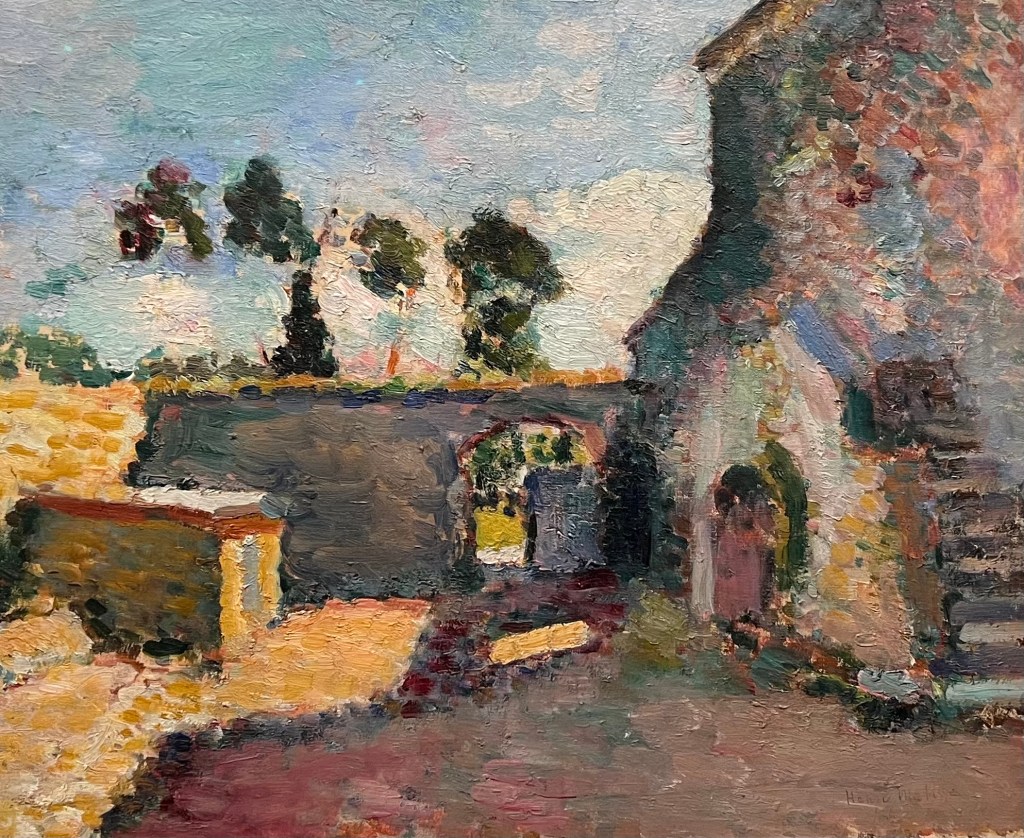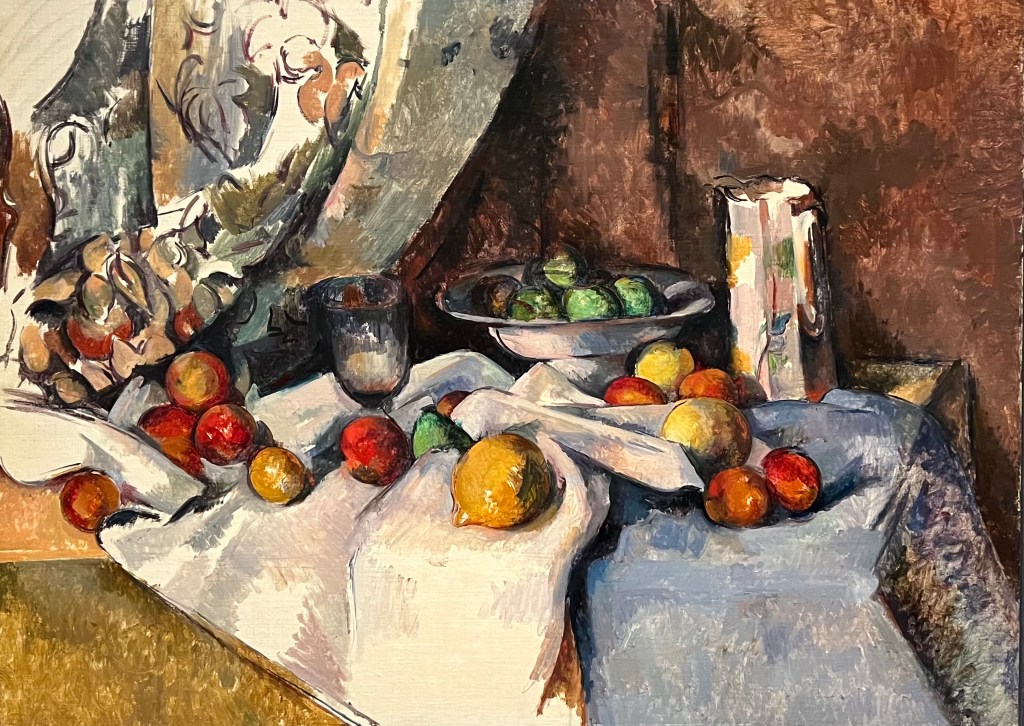All pictures were taken by the author during his visit to The Museum of Modern Art, New York. Texts sourced from exhibit label scripts and museum publication excerpts.
Matisse: The Red Studio
Henri and Amelie Matisse spent the first six months of their married life in Ajaccio, Corsica, where Matisse encountered the Mediterranean sun and sea for the first time. The experience transformed his painting and palette, with realistic description giving away to compositions built primarily on color. The parklike property of this former olive farm was on of Matisse’s favorite sites in Ajaccio; here, his representation of light dissolves details such as the trunks of the olive trees and the door at the top of the stairway.
“Where I got the color red—to be sure, I just don’t know,” Matisse once remarked. “I find that all these things . . . only become what they are to me when I see them together with the color red.” This painting features a small retrospective of Matisse’s recent painting, sculpture, and ceramics, displayed in his studio. The artworks appear in color and in detail, while the room’s architecture and furnishings are indicated only by negative gaps in the red surface. The composition’s central axis is a grandfather clock without hands—it is as if, in the oasis of the artist’s studio, time were suspended.
Large Red Interior depicts a corner of Matisse’s house in Vence, France, where he lived and worked from 1943 to 1949. It shares with The Red Studio the art-within-art device that had remained a constant for Matisse throughout the decades. Only now, however, does the radical flatness of the 1911 painting return.
In many ways, this composition is the antithesis of The Red Studio. Matisse describes the room in clear material details and renders the works of art as virtually blank. In addition to showing a model and a work in progress, it presents a view that vividly brings together indoors and outdoors. Encompassing the full height of the room from the zigzagging floorboards to the scalloped ceiling, Studio, Quai Saint-Michel conveys the closeness of Matisse’s small quarters during the war years, when he spent winters at his Paris apartment.
This is the sole painting in which Matisse depicted the exterior of his Issy studio. The view through the window shows the studio nestled in the surrounding trees (painted blue, like the dressing table, wall, and sky). The studio’s distinctive pitched roof and chimney are also reimagined as blue, while the yellow of the building’s exterior links it to the objects on the table. In one flat plane, Matisse connects inside and outside, home and work, life and art.
This painting was made a few months after Matisse moved into the Issy studio and is his only still-life composition that portrays the wood-paneled walls naturalistically, albeit in blue. A distinctive wooden table occupies the center of the composition. A pot of geraniums and a cloisonne Japanese jar grace the table, across which a floral fabric is draped. The true star of the painting, the flowing textile pulls the real flowers of the geranium and the painted flowers of the ceramic into its own decorative hum.
Appendix I: Collection 1880s-1940s
In this painting, the three classical graces gathered at a water source are depicted as a series of solid, sculptural forms that diverge from the modern language of flattened abstraction with which Picasso was also experimenting during this moment. With their terracotta skin and fluted white garments, the women resemble the earthenware vessels in which they gather water, or columns from the ancient world, offering a reassuring link to tradition after the chaos of World War I.
Dance (I) marks a moment in Matisse’s career when he embraced a reductive approach to painting, seeking the expressive potentials of fundamental elements: line, color, and form. Across this monumental canvas Matisse used only four naturalistic colors: blue for the sky, green for the ground, and black and pale pink in rendering the five figures. When it was painted, its simplification of the human body and radical elimination of perspective were attacked as inept or willfully crude, but Matisse felt that it evoked “life and rhythm.”
Although images of women and children are frequent in the history or art, depictions of pregnancy are rare. Klimt was among the many artists of his time who combined archaic traditions–here Byzantine gold-leaf painting–with a modern psychological subject. The artist’s preoccupation with formative drives like sex and death paralleled Freud’s explorations of the psyche.
The terra-cotta shades and heaviness of the figures in Two Nudes derive from Picasso’s interest at the time in the ancient Iberian sculpture of his native Spain. Like the woman in Demoiselles, with whom she shares a chiseled nose and dark, hollow eyes, the nude seen here holds open a curtain and gazes toward, as though inviting us in.
“Painting from nature is not copying the object.“ Cezanne wrote, “it is realizing one’s sensations.” In this work the artist demonstrates that a still life can be more than an imitation of life–it can be an exploration of seeing and of the very nature of painting. Here, some areas of canvas are left bare, and others, like the drape of tablecloth, appear unfinished. Rules of perspective, too, are broken: the right corner of the table tilts forward and is not aligned with the left side.
Appendix II: Collection 1940s-1970s
Hantai executed this work using his signature method of “pilage”, or folding: he knotted parts of an unstreteched canvas, brushed on paint, and then, once they acrylic had dried, untied the surface to reveal interplays of paint and ground. What looks like a playful image is in reality the chance of outcome of a highly technical procedure. Hantai developed an approach that combined features from diverse art movements, including Surrealism’s automatism–in which conscious control is surrendered–and Pop’s and Minimalism’s elimination of traces of the artist’s hand.
Titled after the ancient Greek goddess of the earth, Gaea is composed of floral colors and organic, somersaulting shapes that reflect the artist’s abiding fascination with the natural world and its primeval origins. Though she painted abstractly, Krasner rejected the notion that her painting was devoid of content—she “wouldn’t dream of” creating a painting from a fully abstract idea, she said. In works like this one, titled after the Earth goddess of the ancient Greeks, the artist claimed to be “drawing from sources that are basic.”
The ghostly scaffolding, swooping calligraphic lines, and blue and yellow washes of this painting most likely depict the view from Sekula’s downtown New York studio, which she shared with composer John Cage and choreographer Merce Cunningham. “Looking outside my window,” wrote the Swiss painter and poet, an immigrant to the United States, “I think of all the contemporary American poets and artists who represent their outlook on this strange country and I find myself beginning to realize that I shall be one of them. I shall begin to speak of … a future that we begin to feel underneath the current of war and strife and uncertainty.”














